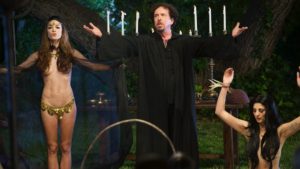 In a case of life sadly imitating art, or art prefiguring some of the more harrowing aspects of life, director Anna Biller was filming her cinematic “magick”-and-eros potion, The Love Witch, in the misty verdant landscapes — and Victorian architecture — of Eureka, California. She wanted, perhaps, the West Coast version of one of those Lovecraftian towns set in the mountains and moors of Massachusetts — Dunwich-on-the-Pacific.
In a case of life sadly imitating art, or art prefiguring some of the more harrowing aspects of life, director Anna Biller was filming her cinematic “magick”-and-eros potion, The Love Witch, in the misty verdant landscapes — and Victorian architecture — of Eureka, California. She wanted, perhaps, the West Coast version of one of those Lovecraftian towns set in the mountains and moors of Massachusetts — Dunwich-on-the-Pacific.
In the story, set in a nebulous “now” that evokes the perfervid Technicolor dreamscapes of Fellini, or Douglas Sirk reimagined as a Roger Corman pioneer in the 60’s and 70’s, the titular witch, who goes by Elaine, is decamping from San Francisco to even more northerly California.
 She falls in with the local witching/pagan community (though these two things are not always interchangeable), evokes a spell or two to bring love her way, and soon finds not only the magic going wrong, somewhat like Mickey in Fantasia, but a whipped up provincial townsfolk wanting to drive her, and other witches, out of town.
She falls in with the local witching/pagan community (though these two things are not always interchangeable), evokes a spell or two to bring love her way, and soon finds not only the magic going wrong, somewhat like Mickey in Fantasia, but a whipped up provincial townsfolk wanting to drive her, and other witches, out of town.
Catching up with director Biller recently, she recounted that once word got out in Eureka what they were filming, “they literally tried to run us out of town on the rail!” The police department, especially, worked so that the film crew would suddenly find locations unavailable to them when they arrived.
So they wound up elsewhere — actually in neighboring Arcata, where the film company was far more welcomed. “It’s not even a Satanic movie!,” Biller emphasized.
What it is is a labor of love from an indie director who found herself as not only producer/writer, but crew head for nearly every key department: editor, composer, production designer, costumer and more. She did collaborate with DP M. David Mullen in the cinematography department, and said they “were looking at a lot of Hitchcock, they way they light interiors,” in the years-long pre-production for the film. Biller recounted that she even made “a lot of the paintings” seen in Elaine’s 70’s-esque apartment, as well as the soap sold in a local magic shop. The “witchy apartment” she helped create also boasted colors “yellow, red, orange — sun colors” from a renowned Tarot deck, the Thoth Tarot.
 There was also a 70’s aura to a wooded house belonging to a local professor, one of the film’s characters who becomes an early consort/victim of the eponymous enchantress. The actual house — or its exteriors — was from a home built in those same 70’s, out in Topanga, for a western (and which was subsequently bought, and preserved by one of those earlier crew members). The interiors for the home were in Laurel Canyon (since most of the film was actually shot in and around Los Angeles). How were they found? Biller said “I did my own scouting. I drove all over heck!”
There was also a 70’s aura to a wooded house belonging to a local professor, one of the film’s characters who becomes an early consort/victim of the eponymous enchantress. The actual house — or its exteriors — was from a home built in those same 70’s, out in Topanga, for a western (and which was subsequently bought, and preserved by one of those earlier crew members). The interiors for the home were in Laurel Canyon (since most of the film was actually shot in and around Los Angeles). How were they found? Biller said “I did my own scouting. I drove all over heck!”
In spite of the one-gal-band labor of love aspects, Biller noted that she still had a good crew for shooting — not only her union DP, but upwards of 15 – 20 on some days. Still mean and lean, of course, but “we were paying them decently.”
Biller, meanwhile, says she remains “interested in creating strong women,” and as well as “shooting on film as long as I can” — since she enjoys the minimized cabling needed for film versus video, and has a certain eye for those saturated, Technicolor-like palettes.
But she also allowed as to how the next one might be “something that’s less complicated, visually.”
The sumptuous visuals here, though, have drive a pretty good reception for the film: Its initially limited release in LA and NY is expanding to more theaters. And striking a contemporary nerve, the Dallas Observer has already called it “the Feminist Sexploitation Jewel you didn’t know you needed.”
Perhaps then it’s the luck of the draw — Thoth Tarot, or otherwise. Or the determination of a director keeping herself as busy as heck, getting her visions off the ground.





